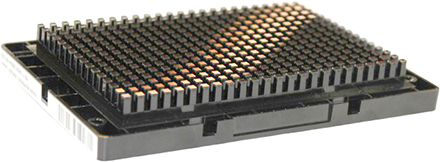
Scion scientist Natalie Graham holds technology that will help shape the future of New Zealand’s radiata pine breeding.
Fitting into a rectangle only slightly bigger than a deck of cards, Scion scientist Natalie Graham holds technology that will help shape the future of New Zealand radiata pine breeding in her hands. Source: Timberbiz
The result of research effort that began in 2014, Graham is holding a single nucleo-tide polymorphism (SNP) array. It is the first large-scale genome-based pedigree identification and genetic selection tool for radiata pine worldwide. It is an affordable and robust genotyping solution that can be used in radiata pine breeding programs in New Zealand.
The project is a collaboration between Scion, the Radiata Pine Breeding Company and the international Conifer SNP Consortium.
The SNP arrays are a game changer for radiata pine breeding, says Scion portfolio leader for Trees for High Volume Wood Products, Andrew Cridge.
“Developing the SNP array significantly reduces the cost of genotyping each pine tree. Being able to genotype individual trees allows tree breeders to use genomic values to select the best trees with improved traits for growth rate, wood quality and enhanced disease resistance qualities,” he says.
Through the use of genomic selection (making decisions based on DNA predictions rather than field trial data), tree breeders can significantly speed up the rate of genetic gain of important production traits.
The importance of this technology advance is considerable. In some ways, the effort began in the 1950s, as geneticists and tree breeders at the (then) Forest Research Institute, together with industry partners, developed methods to identify and genetically select the most superior radiata pine trees. Trees with superior growth and form, resistance to disease and better wood properties such as wood density and structural quality were identified and selected to breed the next generation.
After 70 years of research and ongoing commercial deployment of improved trees, the outcomes are immense. Millions upon millions of radiata pine trees are in production that are more productive, profitable, easier to manage and resilient to disease than previous generations. The cumulative economic benefit to New Zealand over the past decades is significant.
In a 2014 study, Scion geneticists estimated that genetic gain in radiata pine had added multi-billions in income to the national forestry estate. Even that figure was likely too conservative since it did not account for genetic improvement in tree form and branching or wood quality traits.
The development and implementation of the SNP technology is a significant milestone in the long history of conifer breeding in New Zealand.
Radiata Pine Breeding Company general manager Darrell O’Brien explains the commercial importance.
“At 90% of the planted forest estate in New Zealand, radiata pine is the most important forestry species in New Zealand. Even with the benefit of decades of breeding advances, genetic improvement is still constrained by the age of the tree at which we can measure a number of the economically important traits – among them are wood volume, stiffness and density.
“Selecting on genomic values rather than waiting for measurements in older trees has the potential to double the rate of genetic gain per unit of time,” says O’Brien.
“That means that desirable traits can be improved faster and breeding programs can respond more quickly to any changes in climate, market requirements or management practices.”
Genetic improvement is an investment often likened to compound interest earned in the bank, namely each generation improves on the gains made in the previous generation. However, unlike a bank investment, the benefits of genetic improvement are enjoyed annually; more productive trees sequester more carbon and more profitable trees are harvested every year. Anything that accelerates genetic gain also speeds up or amplifies the benefits from that gain.
The first three years of this research were spent mapping the genome of radiata pine – a species that proved to have both a large and complex genome. More than a million SNPs were identified, far too many to be included in a commercial tool.
Graham and her team eventually selected just over 36,000 SNP markers and these became the basis for the commercial SNP array.
Utilising the SNP array, over 35,000 trees have already been genotyped. This information can be correlated with the physical trait measurements and provides an immense wealth of data, enabling fundamental research about the role of genetics, the environment and different silviculture practices.
This resource also enables improvement of the existing radiata pine breeding. In most breeding programmes, the pedigree (parentage or relatedness) between trees is assumed to be known.
However, errors occur. Sometimes identifying trees many years after planting is difficult. Other times unplanned (and unknown) pollinations can slow down or confuse progress in a breeding programme. Genetic verification improves confidence in the entire breeding and deployment pipeline.
The SNP panel was also able to provide information about the distant past of each of our elite radiata pine trees. The DNA results were able to differentiate the geo-graphic ancestry of these trees, tracing back to forests clustered on the Californian coastline or nearby offshore islands.
In 2012, the New Zealand Forest Owners Association had a vision to double productivity of the national radiata pine forestry estate by 2035. The commercial use of this genomic information supports the industry and radiata pine breeders to achieve this goal.






